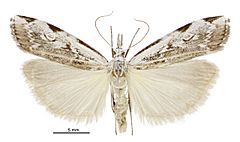Orocrambus tuhualis facts for kids
Quick facts for kids Orocrambus tuhualis |
|
|---|---|
 |
|
| Female | |
| Scientific classification | |
| Kingdom: | |
| Phylum: | |
| Class: | |
| Order: | |
| Family: | |
| Genus: | |
| Species: |
O. tuhualis
|
| Binomial name | |
| Orocrambus tuhualis (C. Felder, R. Felder & Rogenhofer, 1875)
|
|
| Synonyms | |
|
|
The Tuhualis Moth (scientific name: Orocrambus tuhualis) is a fascinating type of moth. It belongs to a group of moths called Crambidae, often known as grass moths. These moths are usually small and have a special way of resting with their wings folded tightly around their bodies.
This particular moth is quite special because it is found only in one place in the world: New Zealand. When an animal or plant lives only in one specific area, we call it endemic.
Contents
Discovering the Tuhualis Moth
This unique moth was first officially described in 1875. It was identified by three scientists: Cajetan Felder, Rudolf Felder, and Alois Friedrich Rogenhofer. They were important naturalists who studied insects and other creatures.
Where Does the Tuhualis Moth Live?
Since the Tuhualis Moth is endemic to New Zealand, you won't find it anywhere else! It has been seen in the South Island of New Zealand. It has also been found in the North Island, specifically near Wellington.
This moth prefers to live in wet, marshy places. Think of areas with lots of water and damp soil, like swamps. These kinds of habitats provide the right conditions for the moth to thrive.
What Does the Tuhualis Moth Look Like?
The Tuhualis Moth is a medium-sized moth. Its wingspan (the distance from the tip of one wing to the tip of the other when spread out) is usually between 23 and 28 millimeters. To give you an idea, that's about the length of a large paperclip or a little less than an inch.
The image in the infobox shows a female Tuhualis Moth. Moths often have patterns and colors that help them blend in with their surroundings, which is a great way to hide from predators.
When Can You See This Moth?
Adult Tuhualis Moths are typically seen flying around during specific months. They have been recorded on wing (meaning flying as adults) from November to December. This period is usually during the late spring and early summer in New Zealand.

